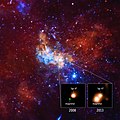ファイル:Magnetar-SGR1745-2900-20150515.jpg

元のファイル (3,600 × 3,600 ピクセル、ファイルサイズ: 3.55メガバイト、MIME タイプ: image/jpeg)
ウィキメディア・コモンズのファイルページにある説明を、以下に表示します。
|
概要
| 解説Magnetar-SGR1745-2900-20150515.jpg |
English: In 2013, astronomers announced they had discovered a magnetar exceptionally close to the supermassive black hole at the center of the Milky Way using a suite of space-borne telescopes including NASA’s Chandra X-ray Observatory.
Magnetars are dense, collapsed stars (called “neutron stars”) that possess enormously powerful magnetic fields. At a distance that could be as small as 0.3 light years (or about 2 trillion miles) from the 4-million-solar mass black hole in the center of our Milky Way galaxy, the magnetar is by far the closest neutron star to a supermassive black hole ever discovered and is likely in its gravitational grip. Since its discovery two years ago when it gave off a burst of X-rays, astronomers have been actively monitoring the magnetar, dubbed SGR 1745-2900, with Chandra and the European Space Agency’s XMM-Newton. The main image of the graphic shows the region around the Milky Way’s black hole in X-rays from Chandra (red, green, and blue are the low, medium, and high-energy X-rays respectively). The inset contains Chandra’s close-up look at the area right around the black hole, showing a combined image obtained between 2005 and 2008 (left) when the magnetar was not detected, during a quiescent period, and an observation in 2013 (right) when it was caught as a bright point source during the X-ray outburst that led to its discovery. A new study uses long-term monitoring observations to reveal that the amount of X-rays from SGR 1745-2900 is dropping more slowly than other previously observed magnetars, and its surface is hotter than expected. The team first considered whether “starquakes” are able to explain this unusual behavior. When neutron stars, including magnetars, form, they can develop a tough crust on the outside of the condensed star. Occasionally, this outer crust will crack, similar to how the Earth’s surface can fracture during an earthquake. Although starquakes can explain the change in brightness and cooling seen in many magnetars, the authors found that this mechanism by itself was unable to explain the slow drop in X-ray brightness and the hot crustal temperature.. Fading in X-ray brightness and surface cooling occur too quickly in the starquake model. The researchers suggest that bombardment of the surface of the magnetar by charged particles trapped in twisted bundles of magnetic fields above the surface may provide the additional heating of the magnetar’s surface, and account for the slow decline in X-rays. These twisted bundles of magnetic fields can be generated when the neutron star forms. The researchers do not think that the magnetar’s unusual behavior is caused by its proximity to a supermassive black hole, as the distance is still too great for strong interactions via magnetic fields or gravity. Astronomers will continue to study SGR 1745-2900 to glean more clues about what is happening with this magnetar as it orbits our galaxy’s supermassive black hole. These results appear in Monthly Notices of the Royal Astronomical Society in a paper led by the PhD student Francesco Coti Zelati (Universita’ dell’ Insubria, University of Amsterdam, INAF-OAB), within a large international collaboration. NASA's Marshall Space Flight Center in Huntsville, Alabama, manages the Chandra program for the agency’s Science Mission Directorate in Washington. The Smithsonian Astrophysical Observatory in Cambridge, Massachusetts, controls Chandra's science and flight operations. |
| 日付 | |
| 原典 | http://www.nasa.gov/mission_pages/chandra/magnetar-near-supermassive-black-hole-delivers-surprises.html |
| 作者 | NASA/CXC/INAF/F. Coti Zelati et al. |
ライセンス
| Public domainPublic domainfalsefalse |
| このファイルはアメリカ航空宇宙局(NASA)によって作成されたものです。NASAの著作権の方針では、特記事項が無い場合、NASAの資料はパブリックドメインとなります。 (詳しくはTemplate:PD-USGov、NASAの著作権の方針について(英語)又はジェット推進研究所(JPL)の画像使用に関するガイドライン(英語)をご覧ください。) |
 | |
 |
注意事項:
|
キャプション
このファイルに描写されている項目
題材
23 9 2014
image/jpeg
ファイルの履歴
過去の版のファイルを表示するには、その版の日時をクリックしてください。
| 日付と時刻 | サムネイル | 寸法 | 利用者 | コメント | |
|---|---|---|---|---|---|
| 現在の版 | 2015年5月15日 (金) 14:08 |  | 3,600 × 3,600 (3.55メガバイト) | Drbogdan | User created page with UploadWizard |
ファイルの使用状況
以下のページがこのファイルを使用しています:
グローバルなファイル使用状況
以下に挙げる他のウィキがこの画像を使っています:
- af.wikipedia.org での使用状況
- el.wikipedia.org での使用状況
- en.wikipedia.org での使用状況
- es.wiktionary.org での使用状況
- ka.wikipedia.org での使用状況
- pt.wikipedia.org での使用状況
- zh.wikipedia.org での使用状況
メタデータ
このファイルには、追加情報があります (おそらく、作成やデジタル化する際に使用したデジタルカメラやスキャナーが追加したものです)。
このファイルが元の状態から変更されている場合、修正されたファイルを完全に反映していない項目がある場合があります。
| 作者 | Chandra X-ray Observatory Center |
|---|---|
| ソース | Chandra X-ray Observatory |
| 使用条件 | |
| 画像の幅 | 3,600 ピクセル |
| 画像の高さ | 3,600 ピクセル |
| 画像のビットの深さ |
|
| 圧縮の種類 | LZW |
| 画素構成 | RGB |
| 画像方向 | 通常 |
| コンポーネント数 | 3 |
| 水平方向の解像度 | 300dpi |
| 垂直方向の解像度 | 300dpi |
| 画像データの並び | 点順次フォーマット |
| 使用ソフトウェア名 | Adobe Photoshop CC 2014 (Macintosh) |
| ファイル変更日時 | 2015年5月13日 (水) 12:30 |
| Exifバージョン | 2.21 |
| 色空間情報 | sRGB |
| デジタルデータの作成日時 | 2014年9月23日 (火) 12:52 |
| メタデータの最終更新日 | 2015年5月13日 (水) 07:30 |
| 評価 (5点満点) | 0 |
| 元文書の一意なID | 4CB4E53C10E28FA4895D0EBBC8579AD6 |
| 著作権情報 | 著作権情報未設定 |
| 連絡先情報 | cxcpub@cfa.harvard.edu
60 Garden St. Cambridge, MA, 02138 USA |
| IIMバージョン | 4 |
